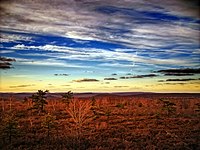
Photo from wikipedia
Abstract Accelerated changes in land cover cause changes in environmental dynamics and may cause land degradation. The goals of the present paper were to analyze changes in land cover and… Click to show full abstract
Abstract Accelerated changes in land cover cause changes in environmental dynamics and may cause land degradation. The goals of the present paper were to analyze changes in land cover and to estimate a future scenario for 2035 using an artificial neural network for the Taperoa River basin, located in northeastern Brazil. The classification of land cover was carried out for years t1 (1990), t2 (1999) and t3 (2002), with the latter being used to validate the land cover prediction to obtain an estimate for year t4 (2035). The land cover classes identified in the basin were (a) water bodies, (b) tree-shrub vegetation, (c) shrub vegetation, (d) herbaceous-shrub vegetation, and (e) herbaceous vegetation. The results of the classifications and of the land cover prediction were analyzed using the kappa coefficient, total operating characteristic (TOC), and area under the curve (AUC). The dynamic modeling of the land cover was based on a multilayer perceptron (MLP) neural network, which presented very good results, with an accuracy = 89.69% after 10,000 iterations, kappa = 0.61 and AUC = 0.67. The results of the land cover change analysis showed a decrease in the tree-shrub class and an increase in the shrub vegetation class between the years analyzed. The scenario predicted for 2035 showed an increase in the herbaceous-shrub vegetation class and a decrease in the area occupied by tree-shrub vegetation.
Journal Title: Global Ecology and Conservation
Year Published: 2020
Link to full text (if available)
Share on Social Media: Sign Up to like & get
recommendations!